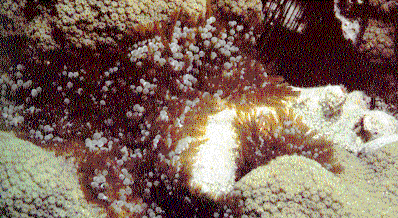by: Patricia Cunningham, Ph.D. and Paul Goetz

|
||
| Although the forked pseudo-tentacles of the branching anemone contain clusters of nematocysts, it is the primary unbranched tentacles extended at night that produce the more virulent stings. Photograph by Pat Cunningham. | ||
|
Branching Anemone (Lebrunia danae) Description. This anemone, though not an uncommon tropical Atlantic species, is seldom seen because of its habit of dwelling in reef crevices. Branching anemones attain a maximum diameter of 12 inches (30 cm). Unlike most other anemones, they possess two distinct types of tentacles: long, unbranched, primary tentacles typical of most anemones, and branched pseudo-tentacles with forked tips that contain nematocyst-filled nodules. During the day, the pseudo-tentacles, which contain zooanthellae, are extended to obtain sunlight for photosynthesis. In contrast, the primary tentacles are extended at night to capture zooplankton. It is these primary tentacles that produce a potent sting. Range and Habitat. Branching anemones range from Bermuda south to the Bahamas, throughout the Caribbean, and south to Brazil. They are commonly found in water 6 to 130 feet (2 to 40 m) deep and are always found camouflaged in a reef crevice with just the pseudo- tentacles exposed. Hazard to Humans. MODERATE TO SEVERE. This species is one of the most venomous of the Atlantic anemones. Contact produces localized burning and itching of the skin followed by redness and swelling. In severe envenomations, fever, chills, abdominal pain, nausea, vomiting, headaches, and prostration can occur. Divers may be stung inadvertently while reaching into crevices. |
||
160 pages, 80 color photographs and 17 illustrations.
Includes Bibliography and Index
ISBN 1-55992-088-2
Available at booksellers and SCUBA Diving shops, or order online from

|
Dealer inquires should be directed to Patricia Cunningham:
118 Dublin Woods Drive
Cary, NC 27513
919/467-3838
E-Mail: info@seascripts.com